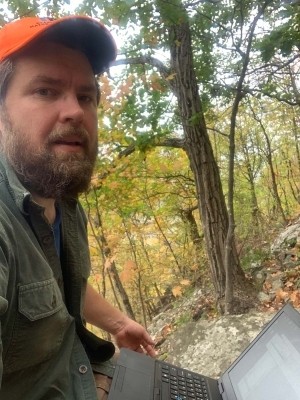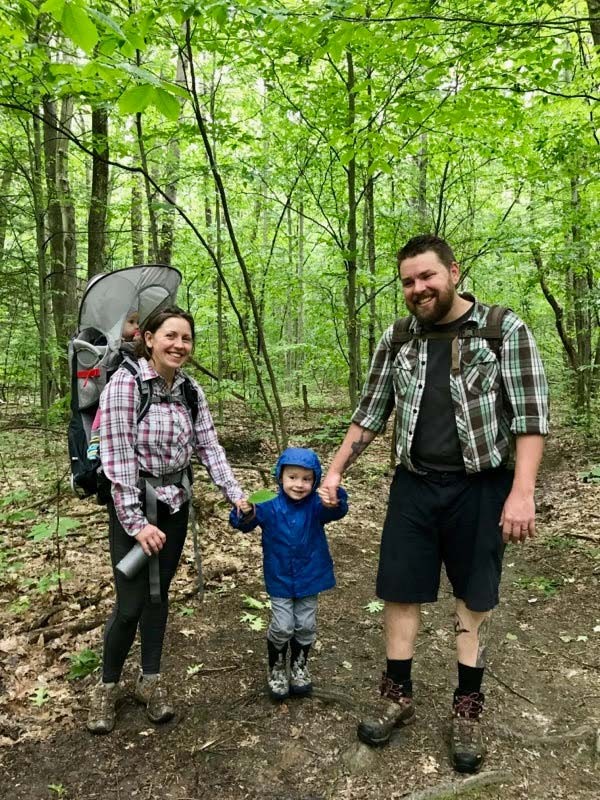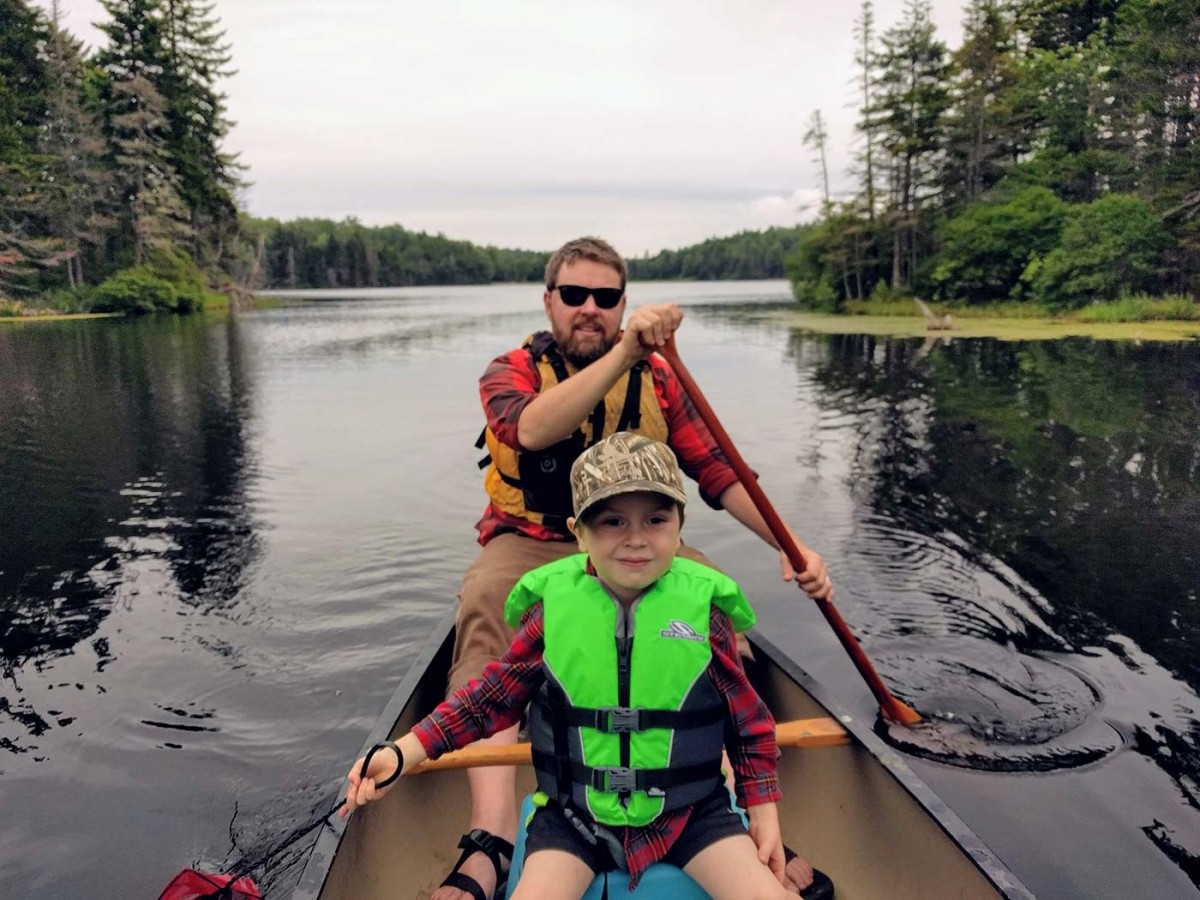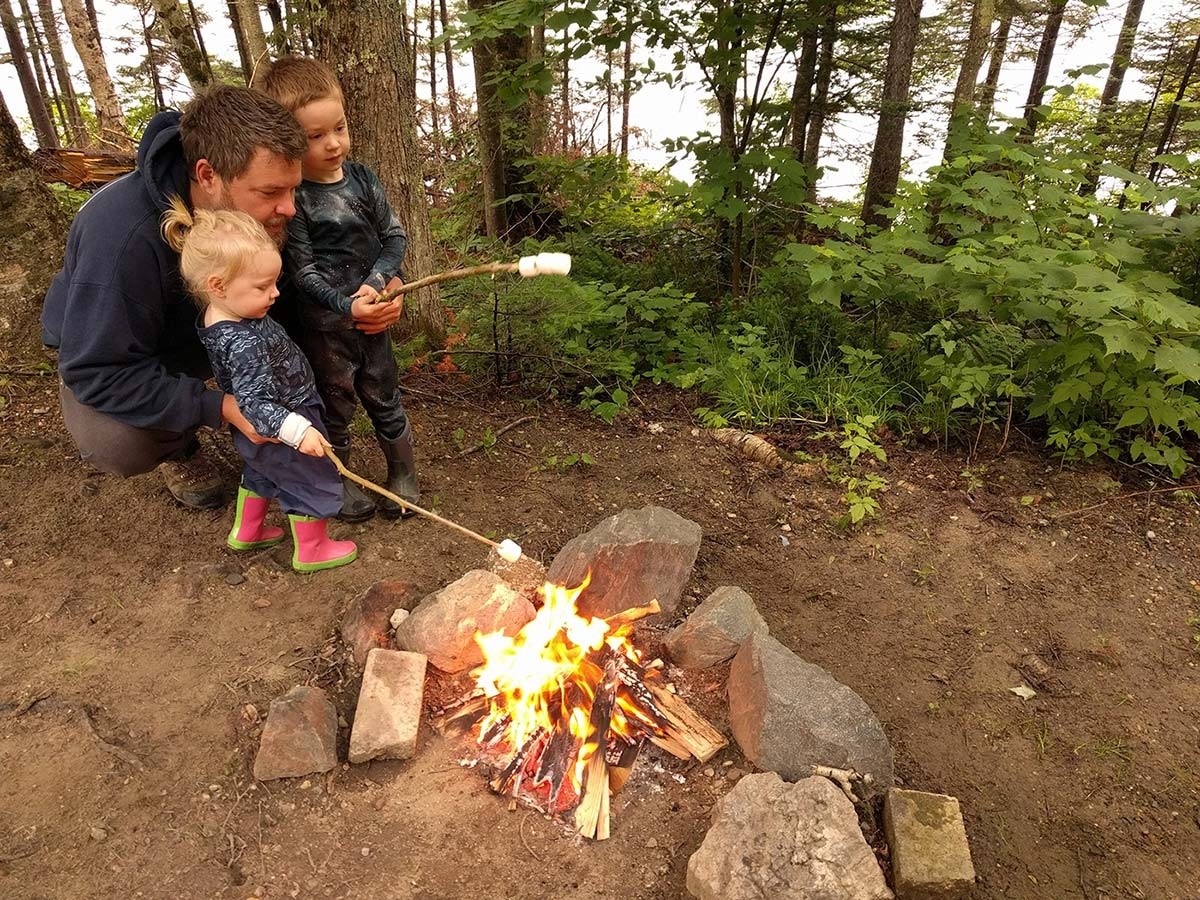Luke Groff is a herpetologist for the Vermont Department of Fish and Wildlife. He and his family moved to Danby in 2019, and although they’re relative newcomers to Vermont, he says they’re happily putting down roots here and expect that after living in 10 different states, Vermont will be their final destination. When he’s not out looking for reptiles and amphibians, Groff may be found tending the family’s huge garden, camping with his kids – ages 2 and 5 – or flipping over rocks and logs to check out the bugs, salamanders, and other creatures living beneath them.
I’m a herpetologist for the state, but I’m also a state lands manager in the Rutland district, which includes Rutland and Bennington County. We have 24 Wildlife Management Areas in our district, and I help manage a number of those. We do everything from contracting road repairs to painting boundary markers on trees to leading nature walks or resolving landowner disputes. It’s part of my job that’s new to me, and I really enjoy it.
I was born and raised in Willow Street in Lancaster County, Pennsylvania. Amish, covered bridges, and hard pretzels are what Lancaster is known for. I lived about 10 miles south of Lancaster city. It felt rural. I grew up in an old farmhouse. My parents had a few acres, surrounded by fields, and there’s a creek that flows through their property. My brother and I spent lots of time in that creek, and we had ribbonsnakes and ratsnakes around. I was also in Boy Scouts, and our troop would go camping every month, even during the winter. I credit Scouts with fostering my interest in the outdoors. It was a lot of fun.
I went to a small school in Wilkes-Barre, Pennsylvania, called Kings College. I was a business major for two years, then an environmental studies major opened. That’s more along the lines of what I should have pursued in the first place, but at 18 years old, I was not planning ahead. Once the option was available to me it was a no-brainer. I liked being outside and looking for little critters, whether it was herps or insects. You have to put some effort in to find the small things that don’t want to be found.
When I graduated, I moved to Hershey and Harrisburg, Pennsylvania and worked for a consulting firm for a few years. It was all landfill expansion projects and gas station mediations. I just wasn’t happy. I didn’t feel like I was on the right side of the conservation fence, where I thought I belonged. But I credit that job with introducing me to the wildlife field. The last couple of months, I helped out with timber rattlesnake and Indiana bat surveys, and it opened up my eyes. I went back to school to get another bachelor’s degree in wildlife and fisheries science at Penn State, then earned a master’s degree in biology from Humboldt State University and a Ph.D. in wildlife ecology from the University of Maine.
Some people enter the field with a specific species in mind. Maybe they grew up hunting and fishing and want to be a deer biologist or a fisheries biologist. I didn’t grow up with that hunting background, so that wasn’t the driver. I think it was just that I spent so much time outside and wanted to know about what was around me. What’s this tree? What’s this bug? What’s this rock? I think it was just fascination and curiosity. Looking for the things that are hard to find is really fun for me. The thing that really sealed the deal in 2005 was that I was offered my first paid job working with amphibians. I worked in Glacier National Park and spent the summer hiking to remote areas of the park and surveying wetlands. We spent two weeks at a time in the backcountry and packed in all gear and supplies. That was a phenomenal summer, and I learned a lot, and that set me on the path for herps.
A lot of the work I do is funded through federal programs, specifically the State Wildlife Grant Program, and that money is specific to what we call SGCN – Species of Greatest Conservation Need. When you’re talking about SGCN, you’re talking about rare species and species that are threatened or endangered. I value all species, but a lot of my time is focused on the most at-risk species.
One project I inherited when I started this job in 2019 is focused on the state’s rare snake species, including the eastern ratsnake, the timber rattlesnake, and the North American racer. The North American racer hasn’t been seen for something like six years in the state, but we monitor the area where it occurred and hopefully we’ll see it again someday. I’m fortunate to partner with an independent researcher who monitors eastern ratsnakes in Addison County. Much of my time is spent monitoring timber rattlesnakes in western Rutland County.
We have two populations of timber rattlesnakes in western Rutland County, and the species is state endangered. My predecessor estimated there are about 400 rattlesnakes left in the state. I work closely with The Nature Conservancy, because they own a lot of important timber rattlesnake habitat. We monitor Vermont’s snakes for signs of disease as they come in and out of the dens. In the fall when the babies are born, we conduct neonate surveys to get an idea of annual reproduction.
Last fall I field tested a passive way to remotely monitor timber rattlesnakes. You can get a PIT (Passive Integrated Transponder) tag implanted in your pet, which has a specific number so if anybody ever finds your pet, they can link it back to you. We put those in wildlife, too. We use snake hooks or tongs to pick up rattlesnakes. It’s like a golfclub with either a U or grasper at the end. We put the snakes in buckets to keep them contained and safe, then we entice them to move into a snake tube – clear plastic tubing of different diameters. Once about half of its body is in the tube, you can pick it up and hold it. Now its head is inside the tube, so it can’t strike. This is when we implant the PIT tag. Last October, we surrounded a den with a cable antenna and, as long as the antenna batteries were working, any PIT tagged snake that moved across it was recorded along with the time and date. My favorite part about this monitoring system is that it collects data without me being present.
We used to have timber rattlesnakes throughout the state. Now they’re restricted to western Rutland County. One reason is habitat – when highways and roads are built on either side of a den, it’s only a matter of time until the population peters out. People used to collect rattles for bounties. And a lot of people are scared of snakes in general. Then you add a venomous species into the mix, and a lot of people see it as something to fear and something to kill. Persecution is still an issue today.
I get why so many people have a fear of snakes. They’re unusual. They have no legs, they slither and squirm, they startle you. But I think they’re fascinating. When people kill snakes, they don’t report it, so we don’t know how many snakes are killed each year. But when you’re only talking about a few hundred rattlesnakes in the state, it doesn’t take long for killings to add up. Female timber rattlesnakes in Vermont don’t reproduce until they’re 8, 9, 10 years old, so they have to live for a number of years before they can replace themselves in the population. It’s an uphill battle. As far as we know, the timber rattlesnake, which is our state’s only venomous snake species, is restricted to three or four towns in western Rutland County. Outside of those towns, unless it’s a released pet, it’s likely not a rattlesnake.
As far as other snakes, I get lots of emails about snakes in basements or snakes in yards. I like to remind people that snakes eat the things we don’t want. They’re one of nature’s rodent controllers, and rodents are often vectors for ticks that carry tick-borne illnesses like Lyme disease. One study estimated that a single timber rattlesnake may incidentally eat as many as 4,500 ticks every year. And of course, they’re important to the food web. They serve as food and they serve as predators. Some linkages may not be clear to us, but it does not mean that they’re not critical to the health of functioning food webs.
Another focus of my job is turtles, which is one of the most threatened vertebrate groups in the world. Certain turtles fetch a high price in the pet trade. We don’t know the extent of the issue, because people don’t tell us when they’re poaching or illegally collecting. A turtle may need 10, 12, 14 years before reaching sexual maturity. Once they’re adults, there’s not a whole lot that will eat them, because they have a hard shell to protect them. But as babies, they’re snacks for just about everybody. Many turtles must survive for a decade or more before adding to the population, all while dodging cars, predators, and poachers. It’s a struggle.
Not all reptile and amphibian pet species are allowed in Vermont, so some get confiscated, some get surrendered, and some get lost and then found. I’ve got two turtles I inherited last year: an ornate box turtle found walking around the streets of Brandon, and a Florida red-bellied cooter that was confiscated by a game warden because the species not allowed in Vermont. My kids fell in love with the box turtle, so we’ve adopted that one. The cooter had some rough living conditions earlier on, so I’m still caring for that one until it’s better. I will be looking for a home for the cooter, but it’s got to be an out of state home.
Some people go out and buy turtles on a whim, but they can live for 30 to 100 years. Sometimes the state gets stuck with these turtles. We’ve maxed out many of our adoption and placement options, so finding homes for these turtles is a real problem. Some people think they’re doing the right thing by setting pet turtles free but that’s a very bad plan. First of all, they’re probably setting that turtle up for a slow death. Second, pet trade turtles carry diseases that can spread to our native turtle populations.
Turtles get hit on roads every spring and summer when they’re moving to nesting and foraging habitats. Turtles can often survive cracked shells, but there are only three reptile rehabilitators in Vermont, and they’re all located near Burlington. Last year I took in two turtles that were hit on roads and provided temporary care. There was a wood turtle from Castleton that recovered nicely and was released, but a snapping turtle I picked up in Sunderland did not survive.
There are a lot of diseases that affect reptiles and amphibians. Last week I responded to an eastern newt die off in Winhall. I counted 312, and I could only see a 4-foot perimeter around the pond, so I’m sure there were many more. I collected samples and sent them to the National Wildlife Health Center for testing. I haven’t got the results back yet, but one of the diseases we’re concerned about is called Bsal (Batrachochytrium salamandrivorans). It’s not known in the U.S. yet, but it’s probably only a matter of time until it arrives. And when it comes, it may decimate many of our salamander populations, and the eastern newt is one of the species that we think is going to be most impacted. So this die off raises concerns.
That day put me in a funk for sure. But then there are days like yesterday when I’m in the middle of a wetland setting traps for this little state endangered spotted turtle. I didn’t find any, but I did find mating wood turtles and a quarter-sized snapping turtle. And there was a heron nest nearby. There are lots of things to love about this job.
Some of my favorite places in Vermont are rattlesnake sites. Our timber rattlesnakes have been using the exact same birthing rocks and overwintering dens for hundreds and hundreds and hundreds of years. When I’m there and I look out over the rivers and the lake and the mountains, I feel connected.






Discussion *